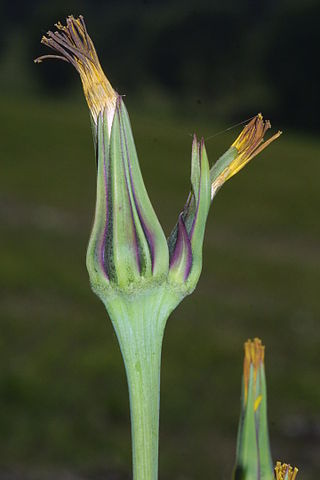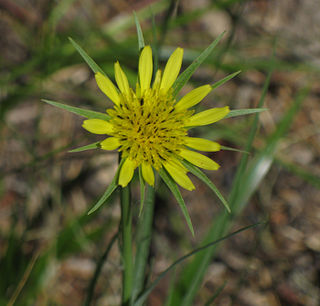
Senecio is a genus of flowering plants in the daisy family (Asteraceae) that includes ragworts and groundsels.

Scorzonera hispanica, commonly known as black salsify or Spanish salsify, also known as black oyster plant, serpent root, viper's herb, viper's grass or simply scorzonera, is a perennial member of the genus Scorzonera in the sunflower family (Asteraceae), cultivated as a root vegetable in the same way as purple salsify, also in the sunflower family. It is native to Southern Europe and cultivated as a crop in Southern and Central Europe. It grows on nutrient poor soils, dry pasture, rocky areas, in thickets and on limy or marly soils of temperate zones.
Goatsbeard or Goat's beard is a common name for several plants and may refer to:

Tragopogon porrifolius is a plant cultivated for its ornamental flower and edible root. It also grows wild in many places and is one of the most widely known species of the salsify genus, Tragopogon. It is commonly known as purple or common salsify, oyster plant, vegetable oyster, Jerusalem star, Jack go to bed, or simply salsify.
Oyster plant is a common name used for various flowering plants, including:

Scorzonera is a genus of flowering plants in the tribe Cichorieae within the family Asteraceae.

Allium canadense, the Canada onion, Canadian garlic, wild garlic, meadow garlic and wild onion is a perennial plant native to eastern North America from Texas to Florida to New Brunswick to Montana. The species is also cultivated in other regions as an ornamental and as a garden culinary herb. The plant is also reportedly naturalized in Cuba.

Aruncus is a genus of clump-forming herbaceous perennial plants in the family Rosaceae. Botanical opinion of the number of species differs, with from one to four species accepted. They are closely related to the genera Filipendula and Spiraea, and are native to mountainous damp woodland in temperate regions of the Northern Hemisphere. Creamy white plumes of flowers are produced above veined and toothed leaflets.

Physocarpus, commonly called ninebark, is a genus of flowering plants in the family Rosaceae, native to North America and northeastern Asia.

Tragopogon pratensis is a biennial plant in the family Asteraceae, distributed across Europe and North America, commonly growing in fields and on roadsides. It is found in North America from southern Ontario to Massachusetts; most of England; on the eastern and southern edges of Scotland; and central Ireland but not the coastal edges.

Tragopogon dubius is a species of salsify native to southern and central Europe and western Asia and found as far north and west as northern France. Although it has been reported from Kashmir and India, recent evidence suggests that specimens from these areas may be a different species. Western salsify has been introduced into North America where it has become widespread, being reported from all the continental United States except for a few in the far south-east, and all provinces of Canada except Newfoundland and the northern territories.

Iva is a genus of wind-pollinated plants in the family Asteraceae, described as a genus by Linnaeus in 1753. Plants of this genus are known generally as marsh elders. The genus is native to North America.

Senecio eboracensis, the York groundsel or York radiate groundsel, is a flowering plant in the daisy family Asteraceae. It is a self-pollinating hybrid species of ragwort and one of only six new plant species to be discovered in either the United Kingdom or North America in the last 100 years. It was discovered in 1979 in York, England growing next to a car park and formally described in 2003. Like many of the Senecio genus it can be found growing in urban habitats, such as disturbed earth and pavement cracks and this particular species only in York and between a railway and a car park.

The Cichorieae are a tribe in the plant family Asteraceae that includes 93 genera, more than 1,600 sexually reproductive species and more than 7,000 apomictic species. They are found primarily in temperate regions of the Eastern Hemisphere. Cichorieae all have milky latex and flowerheads that only contain one type of floret. The genera Gundelia and Warionia only have disk florets, while all other genera only have ligulate florets. The genera that contain most species are Taraxacum with about 1,600 apomictic species, Hieracium with about 770 sexually reproducing and 5,200 apomictic species, and Pilosella with 110 sexually reproducing and 700 apomictic species. Well-known members include lettuce, chicory, dandelion, and salsify.
Hartwrightia is a genus of North American flowering plants in the tribe Eupatorieae of the family Asteraceae. The genus contains a single species, Hartwrightia floridana, native to the US states of Georgia and Florida. The species is sometimes referred to by the common name Florida hartwrightia.

Geropogon is a genus of flowering plants in the family Asteraceae.

Cassida panzeri is a species of beetle in the leaf beetle family, found in the Palearctic realm, and in the Honshu province of Japan. The host plants are in the family Asteraceae, and include Arctium lappa, Scorzonera humilis, Taraxacum officinale, Tragopogon pratensis and Cirsium species.
Tragopogon miscellus, the Moscow salsify, is a species native to the States of Washington and Idaho. Intensive studies over the course of many years have demonstrated that it originated as an allopolyploid hybrid between T. dubius and T. pratensis, both of which are European species naturalized in the US. Tragopogon miscellus has become established in the wild, reproducing by its own, thus deserving recognition as a species.
Tragopogon mirus, the remarkable goatsbeard, is a plant species considered native to certain regions of North America. Intensive studies over the course of many years have demonstrated that it originated as an allopolyploid hybrid between T. dubius and T. porrifolius, both of which are European species naturalized in the US. Tragopogon mirus has become established in the wild, reproducing by its own, thus deserving recognition as a species.

Tragopogon orientalis, common name Oriental goat's beard, is a hemicryptophyte herbaceous annual plant in the family Asteraceae.















